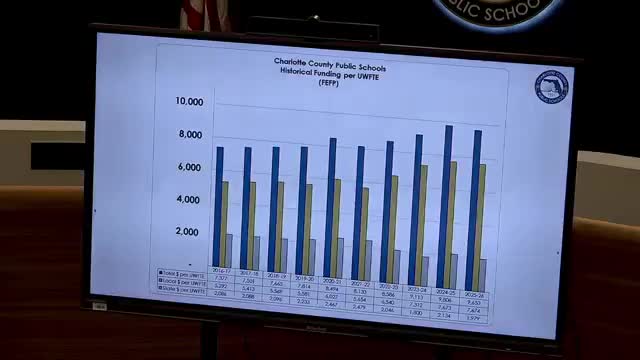Charlotte School Board Evaluates Funding Changes Amid Uncertain Enrollment Data
August 01, 2025 | Charlotte County Public Schools, School Districts, Florida
This article was created by AI summarizing key points discussed. AI makes mistakes, so for full details and context, please refer to the video of the full meeting. Please report any errors so we can fix them. Report an error »

The Charlotte County Public School Board convened on July 31, 2025, for a workshop focused on budgetary discussions and financial planning for the upcoming school year. The meeting addressed several key topics, including funding sources, expenditure breakdowns, and the implications of student enrollment changes on financial projections.
The workshop began with a review of the local discretionary funding, highlighting that while some revenue is generated from interest, it is not sufficient to cover budgetary gaps. The discussion emphasized the importance of understanding the unweighted Full-Time Equivalent (FTE) student counts, which have not significantly changed. The board expressed concerns about the lack of complete data for the fourth calculation, which typically includes February survey data, making it challenging to predict future funding accurately.
A significant portion of the meeting was dedicated to analyzing the sources of funding, revealing that 79% of the district's funding comes from local sources, while 20.5% is derived from state dollars. The board noted that approximately 74.2% of expenditures are allocated to salaries and benefits, underscoring the district's commitment to staffing.
Further discussions detailed the breakdown of expenditures by function, with nearly 58% directed towards direct instruction, which encompasses teacher salaries, classroom supplies, and payments to charter schools. The operational costs, including utilities and custodial services, were also highlighted as major budgetary components.
The board examined departmental spending, particularly in the Exceptional Student Education (ESE) department and transportation, each accounting for about $10 million. The importance of these support services was reiterated, as they play a crucial role in facilitating student learning and well-being.
In response to inquiries about budget transparency, the board confirmed that detailed budget sheets are available, breaking down revenues and expenditures by school and department. This initiative aims to clarify financial allocations and enhance understanding among stakeholders.
The meeting concluded with a consensus on the need for ongoing monitoring of student enrollment and funding changes, as these factors will significantly influence the district's financial health moving forward. The board plans to revisit these discussions in future meetings to ensure that budgetary decisions align with the district's educational goals and community needs.
The workshop began with a review of the local discretionary funding, highlighting that while some revenue is generated from interest, it is not sufficient to cover budgetary gaps. The discussion emphasized the importance of understanding the unweighted Full-Time Equivalent (FTE) student counts, which have not significantly changed. The board expressed concerns about the lack of complete data for the fourth calculation, which typically includes February survey data, making it challenging to predict future funding accurately.
A significant portion of the meeting was dedicated to analyzing the sources of funding, revealing that 79% of the district's funding comes from local sources, while 20.5% is derived from state dollars. The board noted that approximately 74.2% of expenditures are allocated to salaries and benefits, underscoring the district's commitment to staffing.
Further discussions detailed the breakdown of expenditures by function, with nearly 58% directed towards direct instruction, which encompasses teacher salaries, classroom supplies, and payments to charter schools. The operational costs, including utilities and custodial services, were also highlighted as major budgetary components.
The board examined departmental spending, particularly in the Exceptional Student Education (ESE) department and transportation, each accounting for about $10 million. The importance of these support services was reiterated, as they play a crucial role in facilitating student learning and well-being.
In response to inquiries about budget transparency, the board confirmed that detailed budget sheets are available, breaking down revenues and expenditures by school and department. This initiative aims to clarify financial allocations and enhance understanding among stakeholders.
The meeting concluded with a consensus on the need for ongoing monitoring of student enrollment and funding changes, as these factors will significantly influence the district's financial health moving forward. The board plans to revisit these discussions in future meetings to ensure that budgetary decisions align with the district's educational goals and community needs.
View full meeting
This article is based on a recent meeting—watch the full video and explore the complete transcript for deeper insights into the discussion.
View full meeting